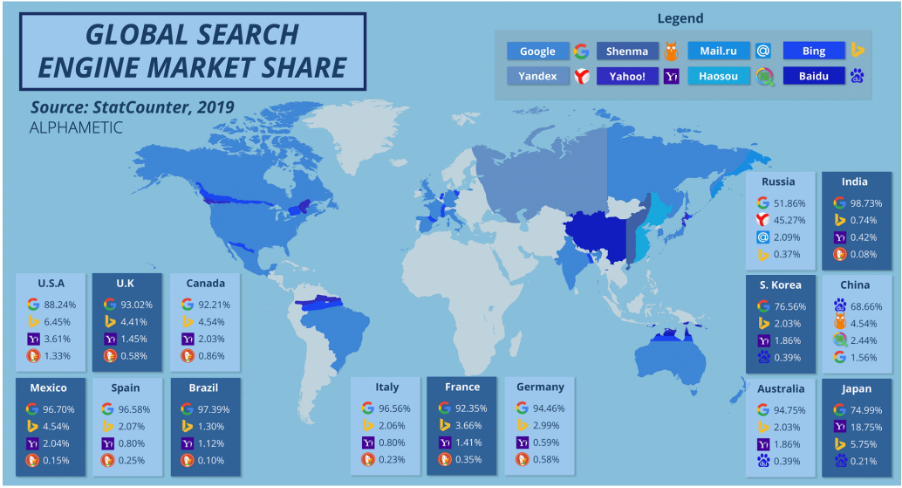It’s all about Google, right?
Not exactly. While Google dominates the worldwide market share of online search, there are countries where Google doesn’t hold the number one position. While it’s true the locations where Google isn’t top dog are few and far between, one such location is China. And for many businesses, China is not a market you want to exclude from your digital marketing strategy.
How big is Google? Pretty big. As at February 2022, Google held a 92% global market share—that’s around 4 billion users. Its closest rival, Microsoft’s bing holds just 2.97%.
Two countries that buck the Google trend are China and Russia. In China, Baidu is the country’s main search engine. Baidu has a market share of around 68%, so it doesn’t enjoy the monopoly that Google does. The other players worth noting in China are Haosou 360, Shenma and Sogou. Google once operated in China, but after refusing to comply to China’s censorship regulations, Google began a withdrawal in 2010. All traffic was directed to Hong Kong (Google.com.hk). Today, Google is completely blocked by China, as are all other sites that sit outside China’s Great Firewall. These include Youtube, Facebook and Skype. Google is still freely accessible in Hong Kong, Taiwan, and Macau.
In Russia, the search engine Yandex is almost on an equal share with Google.
Understanding international search and keyword strategy
When it comes to ranking well in locations outside New Zealand, it all comes down to understanding user intent.
Before embarking on an international strategy, it’s important to research and understand your audience and set an SEO strategy around what you uncover. For now, forget about the fact there may a different language used (Google is already all over that) and consider the different thinking and level of knowledge of your customer.
Google will always try to send a user to the page it thinks is the most helpful. And often, geographical location is a big part of how Google calculates the search result.
For example, in New Zealand we like to wear jandals. If you search for jandals in New Zealand you are probably trying to find somewhere to buy jandals. But in the US, jandals are not a thing. A US person searching for jandal is probably trying to research what the word jandal means. The search intent is different. And if your content doesn’t match the search intent, it will be difficult to achieve high ranking.
To tie this back to our jandal example, if you are trying to sell jandals to Americans, you better make sure your website includes content that covers helpful information and explanations for jandal wearing.
Are your customers here or over there?
Before you begin devising your international search strategy, you will need to determine what type of customers you are looking to connect with. For tourism businesses this is particularly relevant, as they want to capture customers during their travels.
There are two main groups:
- Overseas customers who are searching from their home country
- Overseas customers who are in New Zealand and using local search options
Let’s take a look at the first group first.
Search strategy for international customers in their home country
Firstly, a few important questions to consider.
Is there a market?
Examine your Google Analytics to determine if you have an international audience. Where is there high demand? Select one or two top countries to focus on.
What language are they speaking?
Examine your Google Analytics to see what language your users’ browsers are set to. This will give you data on whether you should consider translated pages or creating a local version of the website, e.g. www.epicjandals.uk
Do keyword research in different geographical locations
Based on the information you have gathered from Step 1 and Step 2, set your keyword research to specific geographical regions. Based on what you uncover, you may decide to create more content on your site that links the audience’s user intent with relevant keywords.
Finding the right keywords to appeal to your international audience requires a bit of work. Research local trends, user behaviour, level of knowledge and search volumes.
Now, let’s take a look at the second group.
Search strategy for international customers in New Zealand
This is where geo-targeting comes into play.
Geo-targeting is when a search engine identifies a user’s location via an IP address, WIFI, or GPS data. Google then serves up content specific to the user’s location. Because Google knows where they are, it can deliver more relevant results, which should hopefully help drive conversions for you as the business owner.
There are a few ways to tackle geo-targeting, however, most require technical knowledge and coding skills. You can geo-target with coding as well as web services like Google Optimize or Unbounce. You can also take a look at Google’s Webmaster guidelines for information on country segmentations and using subdomains or subfolders for specific countries and languages.
An easier way to achieve a similar result is through paid advertising like Google Ads or Facebook Ads where it is fairly easy to set these types of parameters.
It’s important to understand that users now expect content to be personalised to them. If you are in downtown Paris and looking for a patisserie, you are going to expect Google to find you something sweet to eat that’s close by.
Website Translations & Google MUM
The golden rule for translating your website into another language is do it well. Auto-translation services found online often deliver dodgy results. This not only makes things confusing for the user, but it creates an unpleasant user experience. More than likely, they will exit your site, pronto.
Translation is only recommended if you engage a professional service provider and, ideally, a native speaker of the language.
If a full website translation is feeling a little OTT for your business, don’t worry. We expect to see the MUM algorithm update from Google anytime soon. The Multitask Unified Model (MUM) update is expected to improve Google search by overcoming complex and long-tail search queries, language barriers, and handle diverse media types. Most interestingly for international search, MUM is trained in over 75 languages to provide results even if the query is asked in a different language. Clever.
The recap
Successful international SEO is about more than serving up content in a different language. Customers want to experience websites and see information that makes sense to them. Approach international SEO with a country-specific strategy where you understand your market and its demographic.
Before you embark on international SEO
- Ensure you have an audience in the country
- Do your market research, understand your buyer personas
- Ensure you can sell to the market, can you ship there?
- Don’t try to do it all at once, focus on one or two target demographics at a time
If you’re keen to find out more about creating content so you can improve your online presence, contact us.
Image credit: https://alphametic.com/global-search-engine-market-share

